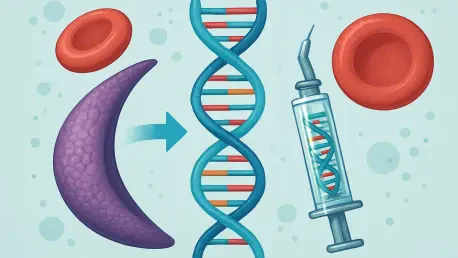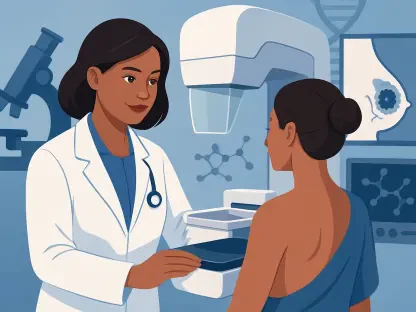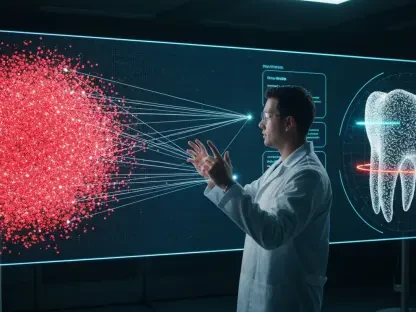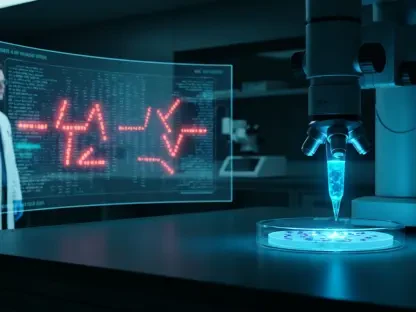In the heart of Washtenaw County, Michigan, a small yet profoundly affected community of roughly 107 individuals battles the relentless challenges of sickle cell disease (SCD), a genetic blood disorder that inflicts severe pain and life-threatening complications on those diagnosed. Primarily impacting Black Americans, this condition has historically been sidelined in terms of research and funding when compared to other diseases with similar prevalence. Now, groundbreaking advancements in gene therapy are sparking a wave of hope, promising not just symptom relief but the potential for a cure. However, as this medical frontier expands, dark clouds gather on the horizon with federal funding cuts threatening to derail progress. These cuts raise critical concerns about whether such innovative treatments will reach the patients who need them most, highlighting a stark divide between scientific possibility and equitable access.
This tension between hope and hardship defines the current landscape of SCD care. At the University of Michigan (U-M), researchers and clinicians are pioneering efforts to integrate gene therapy into treatment protocols, while community advocates rally for visibility and support. Yet, the specter of reduced federal budgets looms large, risking the very programs that track and address disparities in care. This article delves into the transformative potential of gene therapy for SCD, examines the systemic barriers and funding challenges that threaten to undermine it, and explores how local research and advocacy are striving to bridge the gap between innovation and reality for those living with this debilitating disease.
Unveiling the Harsh Reality of Sickle Cell Disease
Sickle cell disease warps red blood cells into a crescent or sickle shape, triggering intense pain crises that often lead to frequent hospitalizations, alongside severe risks such as stroke, infections, and organ damage. In Washtenaw County, this burden falls heavily on a close-knit group of patients and families, many of whom navigate not just physical pain but also systemic inequities embedded in healthcare delivery. The condition’s disproportionate impact on Black Americans amplifies a long-standing narrative of neglect, as SCD has consistently received less attention and resources compared to other genetic disorders with comparable societal impact. This disparity underscores a critical need for targeted interventions that address both the medical and social dimensions of living with SCD in a community striving for better outcomes.
Beyond the clinical challenges, the emotional and financial toll on families cannot be overstated. Patients often face a lifetime of uncertainty, with sudden health crises disrupting education, employment, and daily life. In a region like Washtenaw County, where the affected population is relatively small, the lack of widespread awareness exacerbates isolation, leaving many to advocate for themselves against a backdrop of limited local resources. The historical underfunding of SCD research further compounds these struggles, as it has delayed the development of effective treatments and comprehensive care models. Addressing this multifaceted burden requires a deeper understanding of the disease’s impact and a commitment to rectifying the inequities that have persisted for generations.
Gene Therapy: A New Dawn for Treatment
Recent approvals of gene and cell-based therapies in the United States mark a pivotal moment in the fight against SCD, shifting the focus from merely managing symptoms to targeting the genetic root of the disorder. These innovative treatments hold the promise of long-term remission or even a cure, a prospect that has electrified the medical community and patients alike. Experts at U-M, alongside advocates such as Dr. Wanda Whitten-Shurney from the Sickle Cell Disease Association of America’s Michigan Chapter, view these advancements as potentially transformative, though they emphasize the need for caution. Without extensive long-term data, the full scope of risks and benefits remains unclear, tempering enthusiasm with a call for rigorous follow-up studies to ensure safety and efficacy.
For the SCD community, often referred to as “warriors” in recognition of their resilience, the possibility of a life free from constant pain and hospital visits is a powerful motivator. However, integrating these therapies into mainstream care presents significant hurdles, including high costs and complex administrative processes that could delay access for many. At approved sites like U-M, efforts are underway to navigate these challenges, supported by state-level commitments to prioritize implementation. Despite the optimism surrounding gene therapy, the reality is that its success hinges on overcoming logistical barriers and ensuring that it does not become an unreachable luxury for the majority of patients who rely on public health systems for care.
Research as a Beacon of Progress
At the forefront of understanding and tackling SCD disparities in Michigan is the Michigan Sickle Cell Data Collection Program (MiSCDC), spearheaded by Dr. Sarah L. Reeves at U-M. This initiative stands as the state’s most comprehensive surveillance system, meticulously linking health records to map out demographics, geographic distribution, and healthcare access patterns for those affected by SCD. The insights gleaned from MiSCDC reveal stark gaps in care, such as inconsistent preventive measures among both children and adults, and persistent barriers like transportation that prevent timely medical attention. These findings are not just numbers; they serve as a critical tool for driving accountability and informing policies that aim to deliver the right care at the right moment.
The importance of data-driven approaches cannot be overstated in a field historically marked by neglect. MiSCDC’s work highlights how systemic issues, beyond just medical treatment, shape health outcomes for SCD patients, from limited access to new therapies to disparities in funding allocation. By exposing these inequities, the program lays the groundwork for targeted interventions that could reshape care delivery in Washtenaw County and beyond. However, the sustainability of such initiatives remains precarious, as funding uncertainties threaten to disrupt the very systems that provide this vital information. Protecting and expanding programs like MiSCDC is essential to ensure that research continues to guide meaningful progress in addressing the complex needs of the SCD community.
Voices of Resilience: Patient Experiences
Behind the clinical data and research efforts lie the deeply personal stories of those living with SCD, offering a human perspective on the disease’s challenges. Consider the journey of Dushon “Shon” Sharp Jr., a young man from Washtenaw County whose mother, Davinna Christian, recounts their experiences at U-M. Having endured multiple strokes in childhood, Shon’s transition to adult care brought new hurdles, including missed transfusions due to difficulties accessing veins—a problem attributed to systemic inefficiencies rather than medical impossibility. Despite these frustrations, the family expresses appreciation for the flexibility of U-M’s transfusion clinic, which accommodates weekend and holiday appointments to ease the burden of managing chronic care needs.
These accounts illuminate a dual reality of gratitude and struggle that defines life with SCD. Families often navigate a maze of medical appointments and emergencies while grappling with the emotional weight of an unpredictable condition. In Shon’s case, the resilience required to push through systemic shortcomings mirrors the broader experience of many in the community, where moments of support from healthcare providers are tempered by persistent gaps in care delivery. Such stories underscore the urgent need for improvements that go beyond medical innovation, addressing the practical and emotional barriers that patients face daily. They serve as a poignant reminder that behind every statistic is a person striving for a better quality of life amidst adversity.
Funding Cuts: A Looming Threat to Progress
A significant shadow over the advancements in SCD care is the threat of federal funding reductions, which could unravel years of hard-won progress. Recent budget cuts to the National Institutes of Health (NIH) and proposed slashes to the Centers for Disease Control and Prevention (CDC), including divisions that support initiatives like MiSCDC, have sparked widespread concern within the SCD community. These reductions jeopardize the data infrastructure crucial for tracking health outcomes, evaluating new therapies, and shaping effective policy. While MiSCDC secured funding through September 2026, providing a temporary reprieve, the broader trend of diminished federal support signals a troubling disregard for a disease that has already been historically underfunded.
The implications of these cuts extend far beyond research, impacting the very lifeline of support programs that address SCD’s social and medical needs. Historical disparities in funding allocation for SCD, especially when compared to other conditions, reflect deeper systemic inequities that disproportionately affect Black Americans. Compounding the issue are non-medical barriers like transportation, safe housing, and job flexibility, which influence health outcomes as much as clinical care does. The Washtenaw County Health Department is stepping in to integrate SCD education into community health initiatives, recognizing that tackling these disparities requires a holistic approach. Yet, without sustained financial backing, efforts to close equity gaps risk stalling, leaving patients vulnerable to a future where innovation exists but remains out of reach.
Advocacy: Building Bridges in the Community
In the face of funding uncertainties, Washtenaw County’s SCD community is harnessing the power of advocacy to drive change and raise awareness. Annual events such as the World Sickle Cell Day Walk during Juneteenth celebrations in Ypsilanti and the Strides for Sickle Cell 5K Run/Walk in Ann Arbor serve as vital platforms for education, fundraising, and visibility. Organizers collaborate with churches, schools, and community centers to spread information about SCD and the latest treatment possibilities, fostering a broader understanding of the disease’s complexities. Additionally, advocates are pressing lawmakers in Lansing to ensure that Michigan Medicaid and private insurers cover gene therapies equitably once they become widely available, aiming to prevent cost from becoming a barrier to access.
These grassroots efforts reflect a collective determination to address both medical and social dimensions of SCD care. Beyond public events, local initiatives focus on integrating SCD education into everyday community settings, ensuring that teachers, social workers, and neighbors understand the holistic needs of affected individuals. This approach acknowledges that health disparities extend far beyond hospital walls, requiring a united front to tackle systemic challenges. The advocacy work in Washtenaw County demonstrates how community engagement can amplify the voices of those with SCD, pushing for policies that prioritize equity and access. Such efforts are crucial to ensuring that scientific advancements do not remain isolated successes but translate into tangible improvements for all patients.
Clinical Innovation at the Forefront
At U-M, the Pediatric Sickle Cell Program stands as a model of comprehensive care, blending medical treatment with family support to address the multifaceted needs of young patients. Offerings include hydroxyurea therapy to reduce pain crises, stroke-prevention screenings to mitigate life-threatening risks, and educational resources to empower families in managing the disease. Partnerships with Medicaid through the Pediatric Sickle Cell Improvement Program have proven effective in enhancing compliance with preventive care, leading to fewer hospitalizations and better school attendance for children with SCD. These initiatives highlight how clinical innovation, when paired with community-focused strategies, can significantly improve quality of life for those affected.
The program’s success underscores the importance of a multi-pronged approach that extends beyond the clinic. By addressing barriers to care through flexible scheduling and tailored support, U-M is setting a standard for how healthcare systems can adapt to the unique challenges of chronic conditions like SCD. However, scaling such models to reach all patients remains a challenge, particularly as administrative and financial hurdles threaten to limit access to emerging treatments like gene therapy. The commitment to integrating clinical advancements with practical support systems offers a blueprint for other institutions, emphasizing that effective care must consider both the science of medicine and the realities of patients’ daily lives. This balance is essential to ensuring that progress in treatment translates into real-world benefits.
Navigating the Future with Hope and Caution
Reflecting on the strides made in SCD care, it’s evident that gene therapy marks a historic leap forward, offering a glimpse of a future where a cure might be within grasp. The efforts of researchers at U-M, coupled with the resilience of patients and families in Washtenaw County, paint a picture of determination against daunting odds. Community advocacy events and clinical programs at institutions like U-M have begun to bridge critical gaps, weaving together medical innovation with social support to address the disease’s complex challenges. Yet, the shadow of federal funding cuts lingers, a stark reminder of how fragile progress can be without sustained investment.
Looking ahead, the path to transforming SCD care demands a steadfast commitment to equity and accessibility. Stakeholders must prioritize securing stable funding for research and support programs, ensuring that initiatives like MiSCDC can continue to uncover disparities and guide policy. Simultaneously, efforts should focus on dismantling cost and logistical barriers to gene therapy, making it a viable option for every patient, regardless of socioeconomic status. Strengthening community partnerships and advocacy will be key to maintaining momentum, ensuring that the voices of those affected shape the future of care. By aligning scientific breakthroughs with systemic reforms, there lies an opportunity to redefine the landscape of SCD treatment, turning hope into lasting change for generations to come.









